My Rating: 8.7 /10

First, a quick history lesson! You may or may not know that Kyoto was the old capital of Japan for over 1000 years. 1074 years in fact, from 794-1868. As a consequence, Kyoto has a ton of history, most of which has been incredibly well preserved over the years. Now Kyoto is the home to many UNESCO World Heritage Sites. Nijo Castle is one of them.
In a nutshell, Nijo Castle was built for a great Japanese Shogun by the name of Tokugawa Ieyasu. Let's just call him "The Boss". He was "The Boss" for a while, and wanted to build himself a bad-ass palace to live in while he ruled the country. The result? His very own castle; Nijo Castle.
Along with expansive grounds, gardens, and cherry trees, Nijo Castle is the home to a pretty nice plum blossom grove. Being in season, we decided to check it out with the hopes that the trees were still in bloom.
This monstrous mammoth of a castle was way bigger than I anticipated. It takes an hour to do a quick tour of the grounds, and we didn't have that much time. For that reason, we just headed straight to the plum blossom grove. I took a few snaps along the way.
Did a quick photoshop job on a close-up of a building's details.

This was made of bamboo. Other than that, I have no clue what its deal is...

The Castle Walls, photo by Anastasia
Regrettably the weather wasn't all that great, but I still clicked away on the camera. Every good photographer learns that different conditions offer different photographic opportunities. They may not be the conditions you want (like cotton ball clouds and soft sunny rays), but they are conditions you have to deal with nonetheless. It was a rainy day in Kyoto, so I did my best to capture the images that presented themselves. Here's a handful of my favorite photos.
A few water droplets hanging off the flowers.
Unlike cherry blossoms, plum blossoms have a wonderful aroma. And, as you can see, the aroma is particularly pleasant when you stick it up your nose.
A handful of different plum trees exist that produce a variety of colored flowers. This white tree had a single pink flower that stood out to me.

And, if you ever wonder how I take photos like the one captured above, thank Anastasia for taking this photo of me at work (leaning over the rope to get stability on the tree).
A branch of plum blossoms in their prime.

The path through the plum blossoms in Nijo Castle.
One last photo before headin out.

Right before leaving, I worked up the courage to ask these nicely dressed gals to pose for a picture. Check out the creeper in the background. Creeeeeper.
So that does it, some photos and a brief history lesson of Nijo Castle. Thanks Mr. Tokugawa Ieyasu, you built yourself a pretty cool castle for all of us to enjoy hundreds of years down the road.





















































